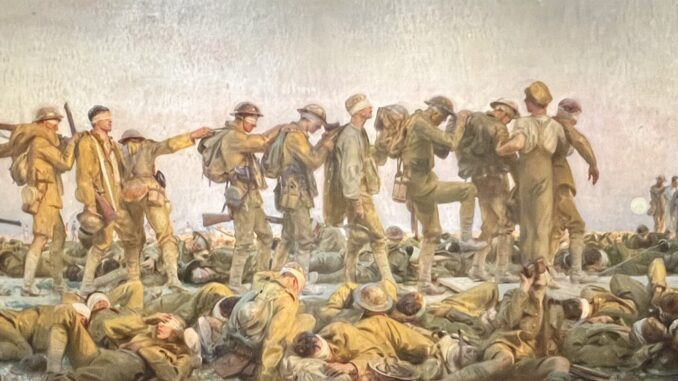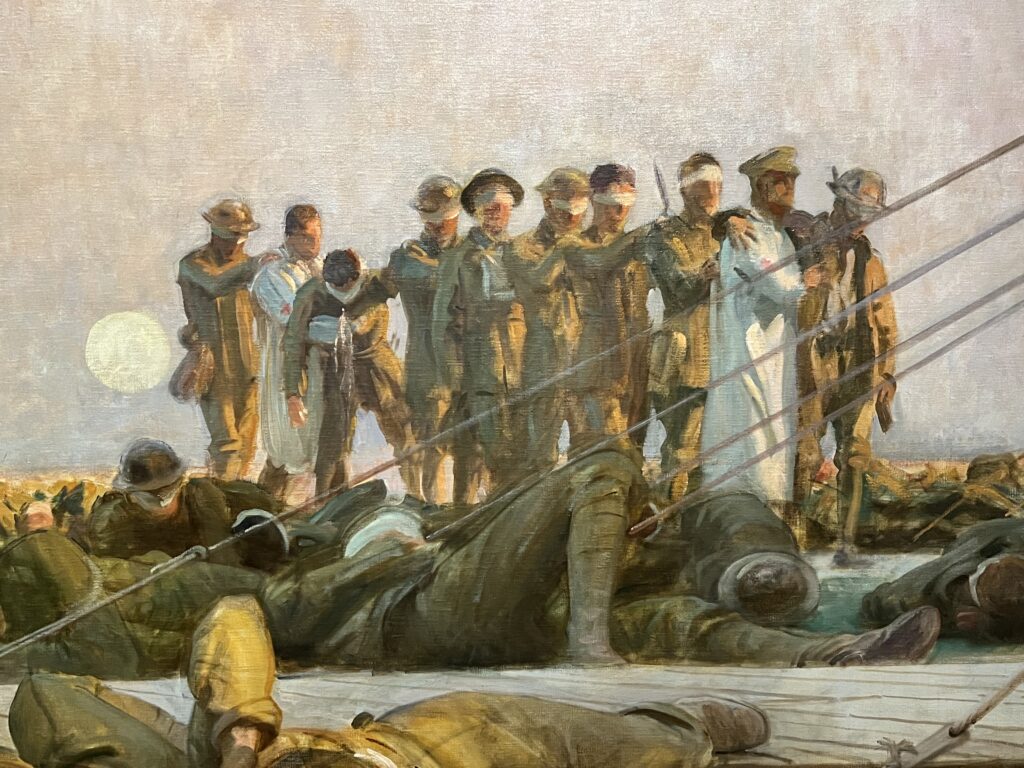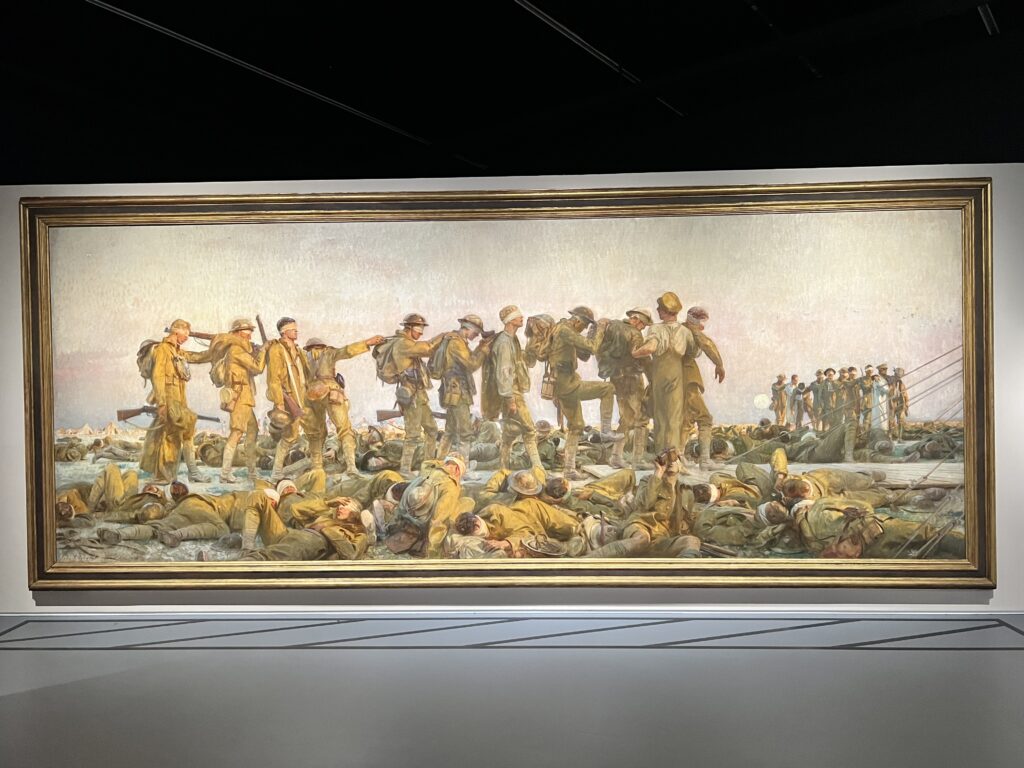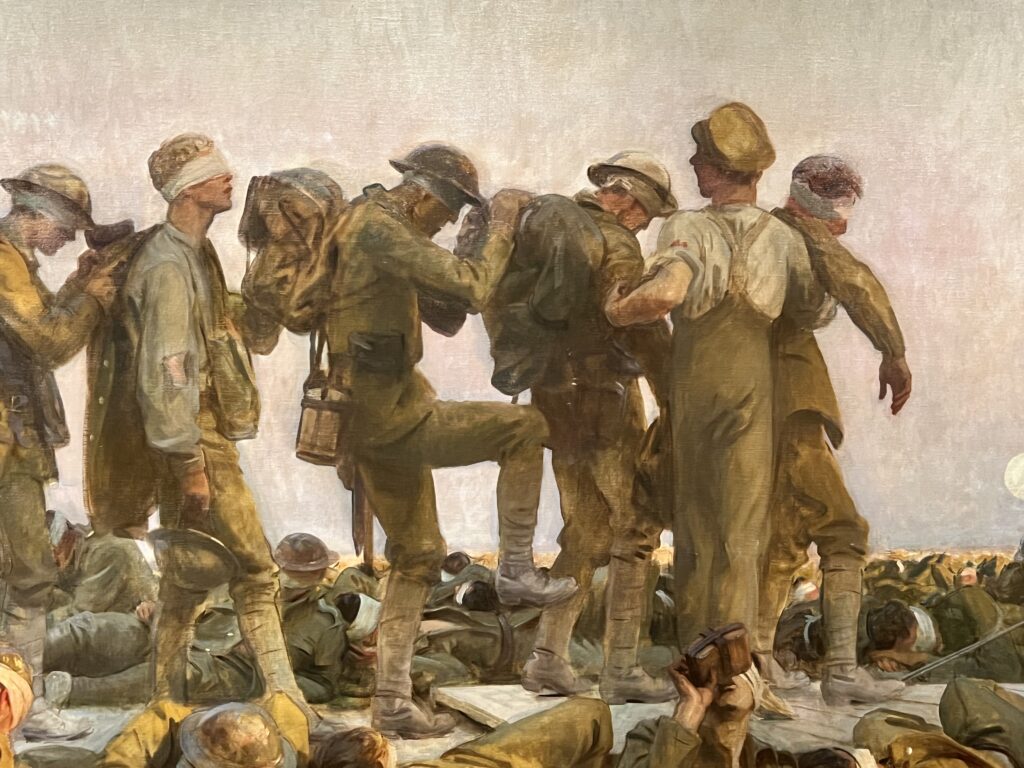
John Singer Sargent was an American expat artist whose luminous portraits of late Victorian and Edwardian society – the aristocrats and the rich – made him much in demand in London, Paris and New York.
(The National Gallery has a few examples, and more can be found in Tate Britain.)
In 1918 the 62 year old Sargent was commissioned to travel to France by the British War Memorials Committee. This was a Lord Beaverbrook-inspired government project that aimed to use artists to record the ‘Great War’: a forward-thinking initiative that also gave us works by Paul Nash, Percy Wyndham Lewis, Stanley Spencer and others.
Sargent was to produce a large canvas for a proposed (but never actually started) ‘Hall of Remembrance’. As with many of the works produced on the Committee’s commission, Sargent’s contribution is probably considerably more downbeat than the government expected, reflecting the shock of the horrors of modern industrial warfare that confronted the artists.
For more of this sort of stuff, follow StuffAboutLondon on social media. For details click here
Sign up here for my monthly newsletter, or follow me on Instagram, or the StuffAboutLondon Facebook page.
Sargent’s painting is ‘Gassed’, an absolutely huge canvas (it measures 20’ x 7’6”, or 6.1 x 2.3m) that can be seen in the Imperial War Museum’s new (and rather wonderful) Blavatnik Gallery.
When Sargent was in France in August 1918 he witnessed men being led to a dressing station after having suffered a German ‘mustard gas’ attack, and it is this that provided the inspiration for his work.
Both sides used chemical agents in WW1. Mustard gas blistered the skin and, although fatal in only 2-3% of cases, caused hospitalisations and blindness (both temporary and permanent).
(Wilfred Owen’s Dulce et Decorum Est records a gas attack:
Gas! GAS! Quick, boys!—An ecstasy of fumbling Fitting the clumsy helmets just in time, But someone still was yelling out and stumbling And flound’ring like a man in fire or lime.— Dim through the misty panes and thick green light, As under a green sea, I saw him drowning.)
Sargent’s painting shows a line of blinded soldiers being led to the dressing station (just off scene on the right of the painting; one can make out the guy ropes that hold up the station’s canvas). One of these ten turners away from us to throw up, another, stepping onto a duckboard, lifts his leg to an exaggerated height to avoid stumbling, emphasising to us that he cannot see the obstacle at his feet.
The path they follow goes through scores of other soldiers lying on the ground, their eyes bandaged, and we can see another short procession of affected men being guided into the station from another direction.
The colours are subdued, downbeat but, in the background, in sunlight, there are other soldiers playing football – the scenes of poisoned men being obviously so commonplace that ‘normal’ life continues.
(It brings to mind another poem, the opening lines of Auden’s 1940 poem ‘Musee des Beaux Arts”
About suffering they were never wrong, The Old Masters: how well they understood Its human position; how it takes place While someone else is eating or opening a window or just walking dully along)




Over 100 years on this is an incredibly sombre piece, Sargent turning his observational genius and psychological insight on a subject that seems light years away from the drawing rooms and country houses of his pre-war portraits. But there were many who, when ‘Gassed’ was first exhibited in 1919, felt that it did not go far enough to represent the horrors of the conflict. They felt it was a sanitised portrayal that would allow viewers to think they were witnessing the worst of battle, but in a manner that would easily be forgotten.
The Blavatnik Gallery is well worth a visit on its own, even without the riches of the rest of the IWM around it, with paintings, artworks, photography and film that record wars of the 20th and 21st centuries giving a different perspective to the written word or the museum’s other exhibits.
[This link takes you to the IWM’s high res image of the painting which allows you to download, zoom etc.]

Buy this book (the website earns a small % for every purchase)
From Bookshop.org (UK only – supports independent booksellers)

Buy this book (the website earns a small % for every purchase)
From Bookshop.org (UK only – supports independent booksellers)

